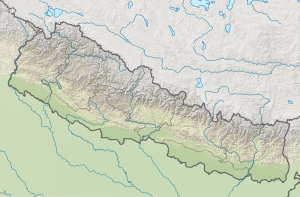Bagmati Rural Municipality, Makwanpur
Bagmati (RM) बागमती गाउँपालिका | |
|---|---|
| Coordinates: 27°19′07″N 85°24′46″E / 27.31861°N 85.41278°E | |
| Country | |
| Province | Bagmati |
| District | Makwanpur |
| Wards | 9 |
| Established | 10 March 2017 |
| Government | |
| • Type | Rural Council |
| • Chairperson | Mr.Sarkesh Ghalan |
| • Vice-chairperson | Mr. Phanidra kumar timalsina |
| Area | |
• Total | 311.79 km2 (120.38 sq mi) |
| Population (2011) | |
• Total | 30,495 |
| • Density | 98/km2 (250/sq mi) |
| Time zone | UTC+5:45 (Nepal Standard Time) |
| Headquarter | Jhurjhure |
| Website | bagmatimunmakawanpur |
Bagmati is a Rural municipality located within the Makwanpur District of the Bagmati Province of Nepal. The municipality spans 311.79 square kilometres (120.38 sq mi) of area, with a population of 30,495, according to the 2011 Nepal census.[1][2]
On March 10, 2017, the Government of Nepal restructured the local level bodies into 753 new local level structures.[3][4] The previous Raigaun, Phaparbari and Betini VDCs were merged to form Bagmati Rural Municipality. Bagmati is divided into 9 wards, with Phaparbari declared the administrative center of the rural municipality.
Demographics
At the time of the 2011 Nepal census, Bagmati Rural Municipality had a population of 30,587. Of these, 60.4% spoke Tamang, 21.6% Nepali, 7.5% Magar, 5.9% Rai, 2.2% Majhi, 1.2% Pahari, 0.5% Newar, 0.2% Bhojpuri, 0.2% Danuwar, 0.1% Bhujel, 0.1% Maithili and 0.1% other languages as their first language.[5]
In terms of ethnicity/caste, 60.5% were Tamang, 12.4% Magar, 8.3% Rai, 4.7% Majhi, 3.9% Pahari, 3.2% Kami, 2.0% Chhetri, 1.7% Hill Brahmin, 1.6% Newar, 0.7% Damai/Dholi, 0.2% Danuwar, 0.1% Brahmu/Baramo, 0.1% Gharti/Bhujel, 0.1% Sarki and 0.3% others.[6]
In terms of religion, 66.3% were Buddhist, 27.8% Hindu, 3.6% Christian, 2.1% Prakriti and 0.2% others.[7]
In terms of literacy, 54.0% could read and write, 3.4% could only read and 42.6% could neither read nor write.[8]
References
- ^ "District Corrected Last for RAJAPATRA" (PDF). www.mofald.gov.np. Retrieved 17 July 2018.
- ^ "स्थानीय तहहरुको विवरण" [Details of the local level bodies]. www.mofald.gov.np/en (in Nepali). Ministry of Federal Affairs and Local Development. Retrieved 17 July 2018.
- ^ "New local level structure comes into effect from today". www.thehimalayantimes.com. The Himalayan Times. 10 March 2017. Retrieved 17 July 2018.
- ^ "New local level units come into existence". www.kathmandupost.ekantipur.com. 11 March 2017. Retrieved 18 July 2018.
- ^ NepalMap Language [1]
- ^ NepalMap Caste [2]
- ^ NepalMap Religion [3]
- ^ NepalMap Literacy [4]



